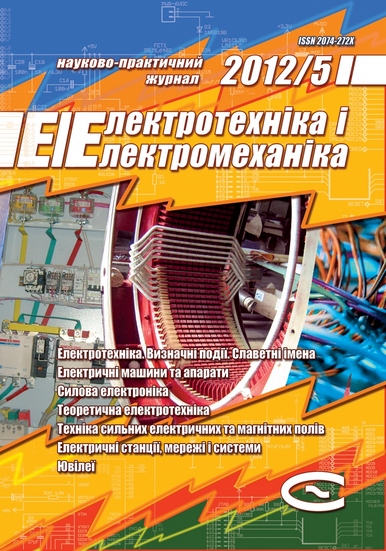A truck’s starter motor with a nonsalient-pole stator
DOI:
https://doi.org/10.20998/2074-272X.2012.5.05Keywords:
starter motor magnetic circuits, nonsalient-pole stator, asymmetrical compensation winding, comparative analysisAbstract
A comparative analysis of two types of trucks’ starter motor magnetic circuits, series-produced salient-pole magnetic circuits and nonsalient-pole stator magnetic circuits with an asymmetrical compensation winding, is presented. It is shown that starter motors with the new electromagnetic excitation system have much better figures over all parameters.
References
Luschik V.D. Elektrichnі mashini postіjnogo strumu z novoyu sistemoyu elektromagnіtnogo zbudzhennya // Elektrotehnіka і elektromehanіka. - 2008. - № 2. - S. 39-41.
Luschik V.D., Varvans'kij A.Yu. Starter-generator postіjnogo strumu z neyavnopolyusnim statorom dlya teplovozіv // Elektrotehnіka і elektromehanіka. - 2009. - № 6. - S. 21-24.
Luschik V.D. Elektrichnij dvigun startera z elektromagnіtnim zbudzhennyam. Patent Ukraїni № 89824. Opubl. 10.03.2010. Byul. № 5.
Luschik V.D. Elektrichnij dvigun postіjnogo strumu z neyavnopolyusnim statorom dlya starterіv legkovih avtomobіlіv // Materialy mezhdunarodnoj nauchno-tehnicheskoj konferencii - Sevastopol': SevNTU, 2010. - S. 22-25.
Downloads
Published
How to Cite
Issue
Section
License
Copyright (c) 2015 V. D. Lushchik, A. Yu. Varvansky

This work is licensed under a Creative Commons Attribution-NonCommercial 4.0 International License.
Authors who publish with this journal agree to the following terms:
1. Authors retain copyright and grant the journal right of first publication with the work simultaneously licensed under a Creative Commons Attribution License that allows others to share the work with an acknowledgement of the work's authorship and initial publication in this journal.
2. Authors are able to enter into separate, additional contractual arrangements for the non-exclusive distribution of the journal's published version of the work (e.g., post it to an institutional repository or publish it in a book), with an acknowledgement of its initial publication in this journal.
3. Authors are permitted and encouraged to post their work online (e.g., in institutional repositories or on their website) prior to and during the submission process, as it can lead to productive exchanges, as well as earlier and greater citation of published work.





